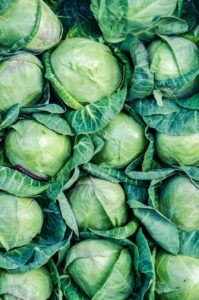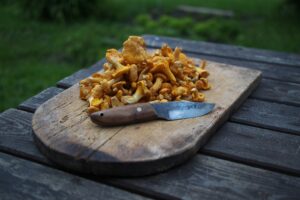
Do you feel full while you’re eating or do you feel uncomfortably full after eating? Are you burping as your stomach burns? Do you suspect an ulcer?
A stomach ulcer occurs when stomach acids eat through the protective lining of your stomach, producing an open sore that your stomach acids leak through. Typical signs and symptoms include burning stomach pain and indigestion.
Ulcers heal when the conditions causing them go away and when you treat the cause.
Many stomach ulcers are caused by an infection, which requires antibiotics, and other medications. What most modern health practitioners don’t remember is your stomach lining is made of mucin, and there are 2 food sources that produce mucin in your stomach. When you provide mucin to your stomach lining, the hole can repair.
And if you eat these mucin-producing foods regularly, you can prevent getting an ulcer.
These two foods are cabbage and marshmallow root.
Old-School
This is old-school medicine, but you know that’s what I love. Medicine before Big Pharma was the best because, in my opinion, doctors focused on the causes of disease, and they prescribed medications for short periods of use; encouraging diet and lifestyle as longterm solutions to restore good health. FYI: vaccines were natural too, so the body’s immune system benefited from the vaccine as opposed to being weakened by them.
I’ll read an old medical journal written before WW II any day.

You have a distinct mucus layer throughout your gastrointestinal (GI) tract composed of highly glycosylated proteins called mucins, which play an essential role in providing lubrication for the passage of food.
Most importantly, mucin patches the tears in your stomach lining.
Mucin
Mucins lubricate the tissues that are around your eyes, in your digestive track, your respiratory system, your reproductive and urinary tracts, within your sinuses and inside the ducts of various glands throughout your body.
Mucin secretes from your mucous membranes. Think about when you catch a head cold – your body produces mucus.

No Ulcers In Eastern Europe
Cabbage is a popular staple food in Eastern Europe, Russia, and the other Slavic countries. The Slavs and Eastern Europeans never got ulcers when Americans were popping antacids like candy. Researchers decades ago wanted to find the reason why.
Eating cabbage regularly was the surprising answer.
Cabbage
Cabbage is often overlooked as a healthy food, but cabbage is highly nutritious and rich in vitamin C, fiber, vitamin K, and produces mucin. Cabbage also supports digestion and heart health.
Cabbage can be eaten raw, cooked, juiced, or fermented.
Rabbits know where it’s at!
Marshmallow Root
Marshmallow (Althea officinalis) is a plant, and its leaves and roots have been used for centuries to make medicine. Marshmallow root forms a protective layer on your skin and on the lining of the digestive tract. It also contains chemicals that can decrease a cough and help fight infections.

Marshmallow root contains mucilage, a gummy substance harvested from certain plants, like cabbage.
When marshmallow root gets wet, it gets soft and sticky, and this soothes your mouth, throat, stomach and intestinal tract.
Marshmallow root (mucilage) helps heal ulcers because it coats your stomach lining.
You should only take marshmallow root for four weeks at a time though. Take a one-week break before resuming use if you feel your ulcer may still be around after a month.
Ulcers are no fun. These painful sores that erode the lining of your esophagus, stomach, or small intestine have created more than 200,000 cases per year in the USA. Eat more cabbage or marshmallow root to make sure you’re not one of the 200,000.
Either that or move to a Slavic country.
_______________
If you want to learn more about healthy living and disease prevention, contact me at janethull.com. Remember that you are never alone when you are looking for good health!
I look forward to supporting you on your journey to alternative health and wellness.
_____________
Disclaimer: This article is for informational purposes only, and is educational in nature. The FDA may not have evaluated some of the statements. This article is not intended to diagnose, treat, cure, or prevent any disease. Please discuss with your own, qualified health care provider before adding supplements or making any changes to your dietary program.
Before taking vitamins, consult your doctor; pre-existing medical conditions or medications you are taking can affect how your body responds to multivitamins.
You have our permission to reprint this article if you attribute us with a live back-link to this article and the youtube links. http://www.janethull.com/
_______________